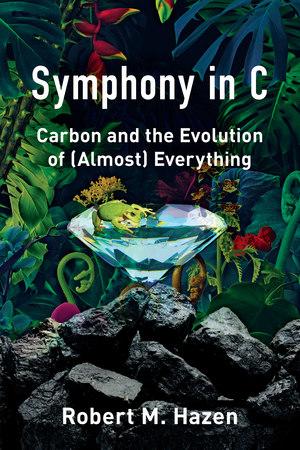A new book by Robert Hazen, Symphony in C: Carbon and the Evolution of (Almost) Everything, celebrates carbon in all its forms

Credit: W. W. Norton & Company
From the walls of our cells, to the gases in our atmosphere, the diamonds in jewelry and the materials that feed civilization’s growth, carbon permeates every aspect of our lives.
A new book by Deep Carbon Observatory (DCO) Executive Director Robert Hazen (Carnegie Institution for Science, USA), celebrates carbon in all its forms, entitled, Symphony in C: Carbon and the Evolution of (Almost) Everything. The book provides a tour through almost 14 billion years of the history of the universe, from the birth of carbon inside stars, to the evolution of life, and the modern-day climate crisis. As he explores carbon’s history, Hazen tells stories about the people who made vital discoveries, and what we still have left to learn.
While Hazen has written many books for scientists and the general public, initially he struggled to find a format to contain this expansive topic. “Writing about carbon is not an easy subject,” said Hazen. “Carbon is not really a story, it’s a concept, a pervasive part of our lives. It touches everything we do.”
Inspired by a suggestion from Sloan Foundation Science Advisor to the DCO Jesse Ausubel (Rockefeller University, USA), Hazen envisioned this enormous project as a symphony, comprised of a series of movements. Guiding these movements are the four classic elements of Greek mythology – earth, air, fire, and water.
The movement “Earth, the Element of Crystals” focuses on solid forms of carbon, including diamonds and other minerals, and the mysteries of Earth’s deep interior. “Air, the Element of Cycles” traces the global carbon cycle, as carbon travels from volcanic eruptions, to the atmosphere, to ocean sediments, and back into the deep through subduction, as well as the impact of that cycle on global climate. In “Fire, the Element of Stuff,” Hazen examines carbon’s industrial side, and how humans have used carbon to fuel the rise of civilization and to synthesize drugs, plastics, petroleum, and other materials we rely on every day. The last movement, “Water, the Element of Life,” follows carbon’s central role in the origin and evolution of life on Earth.
The book’s publication coincides with the “Year of Carbon,” as designated by the Geological Society of London, and the culmination of DCO’s work. “I’m just so thrilled that the book is out there to celebrate this Year of Carbon,” said Hazen, “and to celebrate the end of the first decade and the launch of the next phase of carbon research on Earth.”
An excerpt from the book follows:
Look around you. Carbon is everywhere: In the paper of this book, the ink on its pages, and the glue that binds it; in the soles and leather of your shoes, the synthetic fibers and colorful dyes of your clothes, and the Teflon zippers and Velcro strips that fasten them; in every bite of food you eat, in beer and booze, in fizzy water and sparkling wine; in the carpets on your floors, the paint on your walls, and the tiles on your ceilings; in fuels from natural gas to gasoline to candle wax; in sturdy wood and polished marble; in every adhesive and every lubricant; in the lead of pencils and the diamond of rings; in aspirin and nicotine and caffeine and every other drug you’ve ever taken; in every plastic from grocery bags to bicycle helmets, cheap furniture to designer sunglasses. From your first baby clothes to your silk-lined coffin, carbon atoms surround you.
###
Media Contact
Katie Pratt
[email protected]
Original Source
https:/





